Connecting With Our Past
In 1981, Emily and Russell Fudge’s profound journey with hydrocephalus began when their son, Gerard Swartz Fudge, received a diagnosis at the age of 11. Not far from them, Cynthia Solomon’s son Alex, 7 years old, had also been diagnosed with hydrocephalus. This was a time very different from today. In the early 1980s, there was no internet, leaving parents, patients, and loved ones to seek out the scant information available in medical books and from their doctors. There was no widespread public acknowledgment that the majority of shunts would need to be revised multiple times during a lifetime. There were no programmable or adjustable valves. There were no MRIs. There were no such people as Board Certified Pediatric Neurosurgeons and no Patient’s Bill of Rights. And there was nowhere to turn for support and guidance.
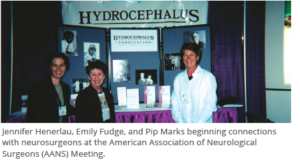 Both families were under the care of Dr. Michael S.B. Edwards, at the University of California San Francisco (UCSF). After Gerard’s second shunt revision, Emily and Russell expressed their feelings of isolation and frustration, spurring Dr. Edwards and his neurosurgical nurse, Lori Howell, to host a few small, informal gatherings of his patients. Emily met Cynthia at one of the very first meetings and the seeds of the Hydrocephalus Association were planted. It was 1983.
Both families were under the care of Dr. Michael S.B. Edwards, at the University of California San Francisco (UCSF). After Gerard’s second shunt revision, Emily and Russell expressed their feelings of isolation and frustration, spurring Dr. Edwards and his neurosurgical nurse, Lori Howell, to host a few small, informal gatherings of his patients. Emily met Cynthia at one of the very first meetings and the seeds of the Hydrocephalus Association were planted. It was 1983.
In 1984, they decided to host a more formal meeting, asking Dr. Edwards to speak about hydrocephalus and invite a large number of his patients. At that meeting, they proposed the idea to create an independent, patient-focused organization with the goal of providing personal support for families affected by hydrocephalus. It was met with great enthusiasm. With a $1,000 grant from UCSF and Dr. Edwards, and organized out of the basement of the Fudge home by a dedicated core group of individuals that included Emily and Russell Fudge, Cynthia Solomon, Pip Marks, and Jennifer Henerlau, they set their early priorities. Namely, to connect individuals and to provide resources.
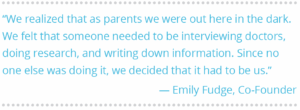 In 1986, the Hydrocephalus Foundation of Northern California was incorporated and received non-profit status. (Our name would change to the Hydrocephalus Association (HA) in 1991 to reflect our expansion and growth). In this same year, About Hydrocephalus - a Book for Families was published. These two events were significant in the future trajectory of the association because it served to connect two key stakeholders to the fledgling group. Namely, the families, who now had an invaluable resource about hydrocephalus, and the pediatric neurosurgeons, who had a trusted resources to help their patients.
In 1986, the Hydrocephalus Foundation of Northern California was incorporated and received non-profit status. (Our name would change to the Hydrocephalus Association (HA) in 1991 to reflect our expansion and growth). In this same year, About Hydrocephalus - a Book for Families was published. These two events were significant in the future trajectory of the association because it served to connect two key stakeholders to the fledgling group. Namely, the families, who now had an invaluable resource about hydrocephalus, and the pediatric neurosurgeons, who had a trusted resources to help their patients.
The theme of connection became central to the formation of the association and the development of its programs. With the About Hydrocephalus book in hand, Emily, Cynthia, Pip, and Jennifer began attending the professional neurosurgical society meetings. By connecting with neurosurgeons, they were able to recruit the best doctors, many of whom were the pioneers of pediatric neurosurgery, to serve on a newly established
Medical Advisory Board (MAB). Soon doctors wanted to be involved with the association; it was an honor for them. This opened new avenues for collaboration, fostering partnerships between the association and the medical community, and ultimately enhancing understanding and support for individuals with hydrocephalus.
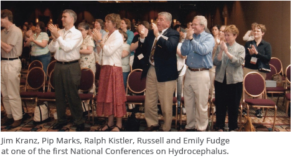 When Cynthia’s son’s shunt kept failing, she decided to call the manufacturer and spoke with Marvin Sussman, a vice president with Cordis. It was apparent that he cared deeply about these patients and Cynthia realized that industry partners brought great value to the association, as well. In the early days, an industry representative served on the Board of Directors. Now our relationships endure through support of and collaboration on our support and educational programs. Connecting the companies with the patient community allowed for an exchange of information and learning for both the patients and the company executives, and it deepened a commitment to improve lives.
When Cynthia’s son’s shunt kept failing, she decided to call the manufacturer and spoke with Marvin Sussman, a vice president with Cordis. It was apparent that he cared deeply about these patients and Cynthia realized that industry partners brought great value to the association, as well. In the early days, an industry representative served on the Board of Directors. Now our relationships endure through support of and collaboration on our support and educational programs. Connecting the companies with the patient community allowed for an exchange of information and learning for both the patients and the company executives, and it deepened a commitment to improve lives.
The founding members had the foresight to connect the three key groups who could improve care for the patients, thereby creating a strong organizational foundation for HA. These early connections - connecting families to each other and connecting the medical professionals and industry representatives to the families - facilitated growth and reach into new areas where gaps existed, specifically, with the federal government and the scientific community. The first significant achievement in this area was Cynthia’s tireless work to have hydrocephalus officially recognized by the National Institutes of Health (NIH) as an eligible condition to receive research funding. Since that time, HA has continued to serve as a catalyst for increased research dollars from NIH, other federal agencies, and the Department of Defense. We do this through direct advocacy as well as by connecting and inspiring scientists to focus on hydrocephalus through the Hydrocephalus Association Cynthia Solomon Resident’s Prize, our various funding mechanisms, and the three research networks. Those networks include the pediatric-focused Hydrocephalus Clinical Research Network (HCRN), the Adult Hydrocephalus Clinical Research Network (AHCRN), and the HA Network for Discovery Science (HANDS).
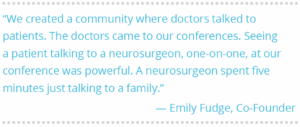 Over the last 40 years, we grew as our mission grew, working through new connections to build an international reach and reputation in both the patient and scientific communities. Forty years ago, could this group of determined and committed individuals have imagined that the Hydrocephalus Association would become the nation’s largest and most widely respected advocacy organization dedicated to hydrocephalus? We have brought on professional staff to work daily on our mission. We have a Board of Directors composed of business and legal professionals, entrepreneurs, and doctors, the majority with a direct connection to hydrocephalus as either individuals living with the condition themselves or loved ones. We have a Medical Advisory Board composed of 25 of the leading neurosurgeons, neurologists, neuropsychologists, neonatologists, and nurses. And we have deep relationships with both established and newly emerging industry partners who are working to improve the management of hydrocephalus.
Over the last 40 years, we grew as our mission grew, working through new connections to build an international reach and reputation in both the patient and scientific communities. Forty years ago, could this group of determined and committed individuals have imagined that the Hydrocephalus Association would become the nation’s largest and most widely respected advocacy organization dedicated to hydrocephalus? We have brought on professional staff to work daily on our mission. We have a Board of Directors composed of business and legal professionals, entrepreneurs, and doctors, the majority with a direct connection to hydrocephalus as either individuals living with the condition themselves or loved ones. We have a Medical Advisory Board composed of 25 of the leading neurosurgeons, neurologists, neuropsychologists, neonatologists, and nurses. And we have deep relationships with both established and newly emerging industry partners who are working to improve the management of hydrocephalus.
At the core of all of these connections is the individual living with hydrocephalus, their family members, and their care providers. True to the initial intent, HA continues to bring the patient voice to every aspect of our work. And the staff honors the legacy of the founders by continuing to develop trusted resources for navigating the journey with hydrocephalus.
HA’s Founders and Visionaries
Meet the Founders and Visionaries of the Hydrocephalus Association - Trailblazers who ignited the path towards a brighter future for those affected by hydrocephalus. Their dedication and innovation have shaped our journey, and their legacy continues to inspire
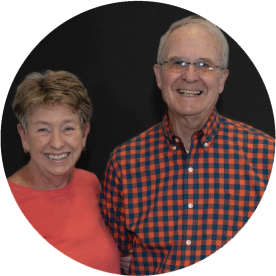
Emily and Russell Fudge
Emily served as the Executive Director of the Hydrocephalus Association from 1989 to 2004. Russell served on the Board of Directors from its inception to 2013. Their son, Gerard, passed away in 1992. The first Hydrocephalus Association Scholarship was established in 1994 by the Fudge Family and their friends in memory of Gerard.

Michael S.B. Edwards, MD
Dr. Edwards was one of the first pediatric-focused neurosurgeons in California and provided the seed funds to support the Hydrocephalus Association so that patients could receive the information and support they need.
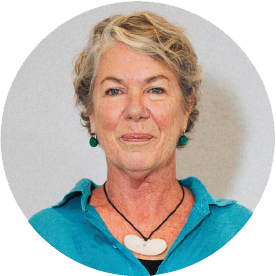
Pip Marks
Pip served as the Outreach Coordinator and then the Director of Support and Education from 1988-2012. She was a lifeline for countless families who called the association. She also raised awareness with the medical community for a greater understanding of hydrocephalus.
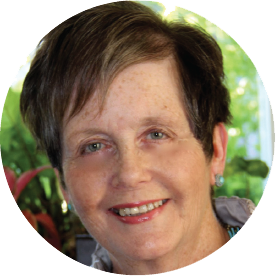
Cynthia Solomon
Cynthia was a nationally recognized health advocate who founded FollowMe™ (2000), a health information technology provider for vulnerable populations. Her entrepreneurial spirit drove many of the early accomplishments of the association.
Celebrating Milestones and Empowering Hope at Our 40th Anniversary Gala
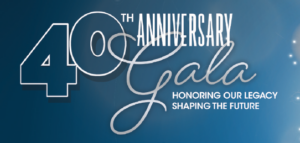 The Westin Anaheim Resort was ablaze with excitement and purpose on November 10, 2023, as the Hydrocephalus Association (HA) commemorated four decades of impact, dedication and support for our community at our 40th Anniversary Gala. The event brought together a diverse ensemble of researchers, physicians, industry partners, individuals living with hydrocephalus, their families, and esteemed supporters for an evening that blended celebration, gratitude, and a resounding call for progress.
The Westin Anaheim Resort was ablaze with excitement and purpose on November 10, 2023, as the Hydrocephalus Association (HA) commemorated four decades of impact, dedication and support for our community at our 40th Anniversary Gala. The event brought together a diverse ensemble of researchers, physicians, industry partners, individuals living with hydrocephalus, their families, and esteemed supporters for an evening that blended celebration, gratitude, and a resounding call for progress.
The night unfolded with an atmosphere of warmth and socialization, fostering connections among attendees as they mingled and engaged in the silent auction, igniting the spirit of generosity right from the start.
The Gala program, steeped in reverence for HA’s legacy, began with a touching video chronicling the history of the association. Embracing our founders and the visionary leaders who pioneered HA’s journey, the video served as a testament to their tireless dedication and the impactful strides made over the years, while setting the stage for the work left ahead.
 A heartfelt moment unfolded as Emily and Russell Fudge were honored for their invaluable contributions. Individuals living with hydrocephalus from their young teens to adulthood took the stage to express their gratitude for how HA has touched their lives and been uplifted by the Fudges’ steadfast support and visionary leadership.
A heartfelt moment unfolded as Emily and Russell Fudge were honored for their invaluable contributions. Individuals living with hydrocephalus from their young teens to adulthood took the stage to express their gratitude for how HA has touched their lives and been uplifted by the Fudges’ steadfast support and visionary leadership.
In a deeply moving tribute, the Hydrocephalus Association honored Cynthia Solomon, a cherished founder whose passing left a profound legacy resonating within our community. In recognition of Cynthia’s strategic impact, HA announced the renaming of the Hydrocephalus Association Resident’s Prize to the Hydrocephalus Association Cynthia Solomon Resident’s Prize, a testament to her remarkable character and contributions. Cynthia’s son was invited to the stage, graciously accepting the honor. He shared the pride that his mother would have in the growth of the association and its vision for the future.
 The evening continued with a delightful dinner, complemented by the excitement of a dynamic live auction. Attendees were captivated by a moving video presentation that showcased the poignant stories of families navigating life with hydrocephalus. The presentation was followed by Erin and Pieter Berger who shared their personal journey with the audience, offering a touching testament to the resilience and challenges faced by those living with hydrocephalus. Moved by the moment, actor Debbie Allen joined them on the stage to say a few words. The presentations emphasized the crucial need for advancements in treatments and emphasized the urgency of finding a cure, shining a spotlight on HA’s central role as the primary force propelling research and fostering hope. A high-energy Fund A Cure paddle raise followed, where attendees united in a collective effort, raising funds to bolster HA’s critical mission.
The evening continued with a delightful dinner, complemented by the excitement of a dynamic live auction. Attendees were captivated by a moving video presentation that showcased the poignant stories of families navigating life with hydrocephalus. The presentation was followed by Erin and Pieter Berger who shared their personal journey with the audience, offering a touching testament to the resilience and challenges faced by those living with hydrocephalus. Moved by the moment, actor Debbie Allen joined them on the stage to say a few words. The presentations emphasized the crucial need for advancements in treatments and emphasized the urgency of finding a cure, shining a spotlight on HA’s central role as the primary force propelling research and fostering hope. A high-energy Fund A Cure paddle raise followed, where attendees united in a collective effort, raising funds to bolster HA’s critical mission.
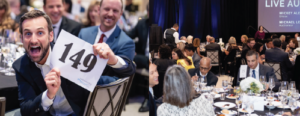 Closing the evening on a whimsical note was the performance by Justin Willman, creator and star of the Netflix hit Magic for Humans, whose blend of comedy and mesmerizing magic enthralled and captivated the audience, leaving a lasting magical impact.
Closing the evening on a whimsical note was the performance by Justin Willman, creator and star of the Netflix hit Magic for Humans, whose blend of comedy and mesmerizing magic enthralled and captivated the audience, leaving a lasting magical impact.
 The 40th Anniversary Gala was a testament to HA’s steadfast dedication, uniting hearts and minds in a shared vision for a future free from the burdens of hydrocephalus. As the night concluded, attendees departed, carrying with them a renewed sense of purpose and resolve to continue the fight for advancements and hope.
The 40th Anniversary Gala was a testament to HA’s steadfast dedication, uniting hearts and minds in a shared vision for a future free from the burdens of hydrocephalus. As the night concluded, attendees departed, carrying with them a renewed sense of purpose and resolve to continue the fight for advancements and hope.
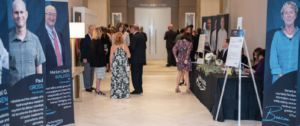 In celebrating this milestone, the Hydrocephalus Association reaffirmed its pledge to persist in driving forward research, support, and advocacy, ensuring that every step brings us closer to a world where hydrocephalus is a thing of the past.
In celebrating this milestone, the Hydrocephalus Association reaffirmed its pledge to persist in driving forward research, support, and advocacy, ensuring that every step brings us closer to a world where hydrocephalus is a thing of the past.
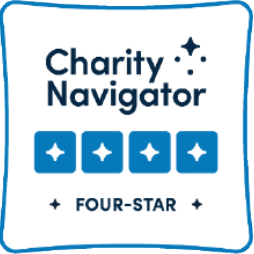 The Hydrocephalus Association is proud to share that we have earned a top-rated Four-Star status from Charity Navigator, one of the most trusted charity evaluators in the U.S. What does this mean for you and our mission?
The Hydrocephalus Association is proud to share that we have earned a top-rated Four-Star status from Charity Navigator, one of the most trusted charity evaluators in the U.S. What does this mean for you and our mission?
Charity Navigator serves as the quality checkers for charities. For over 20 years, they’ve helped more than 11 million donors make smart choices about where to give their hard-earned money. They look at four important factors to measure how well a charity is doing its job. One of those is “Accountability & Finance.” In simple terms, it means they check if we are using your donations wisely. Are we making sure every dollar goes to where it matters most, like finding a cure for hydrocephalus or improving the lives of those who live with it? The answer is a resounding “Yes!”
“We are delighted to provide the Hydrocephalus Association with third-party accreditation that validates their operational excellence,” said Michael Thatcher, President and CEO of Charity Navigator. “The Four-Star Rating is the highest possible rating an organization can achieve. We are eager to see the good work that the Hydrocephalus Association is able to accomplish in the years ahead.”
Being a Four-Star charity is a big deal. It’s like Charity Navigator’s gold star. With your support, we’ve become a strong national organization. We’re the top resource for our community and the largest non-governmental contributor to hydrocephalus research in the U.S. We’re proud to be among the best charities in the nation.
“As we mark our 40th anniversary this year, achieving a Four- Star Charity Navigator rating serves as an additional affirmation of our steadfast dedication to sound governance and fiscal responsibility,” remarked Diana Gray, President and CEO of the Hydrocephalus Association. “We aspire for this recognition to introduce our mission to fresh supporters, individuals who can join us in advancing our quest to discover a cure for hydrocephalus and enhance the quality of life for those affected by this condition.”
So, what’s the takeaway? When you donate to the Hydrocephalus Association, you can be confident that your money is making a real difference. It’s helping us work towards a cure and improve the lives of those living with hydrocephalus. Thank you for being a part of our mission!
Strategic Plan 2023-25
We are excited to announce the formulation of our new strategic plan for 2023-2025, focused on advancing our mission to find a cure for hydrocephalus and improve the lives of those affected by the condition. Our vision remains a world without hydrocephalus. This plan is built on four key pillars:
- Engaging and connecting with the hydrocephalus community.
- Funding and promoting high-impact research to enhance care, treatments, prevention, and ultimately discover a cure for hydrocephalus.
- Supporting and advocating for individuals affected by hydrocephalus at every age and stage of life.
- Enhancing the medical community's care and management of hydrocephalus patients.

